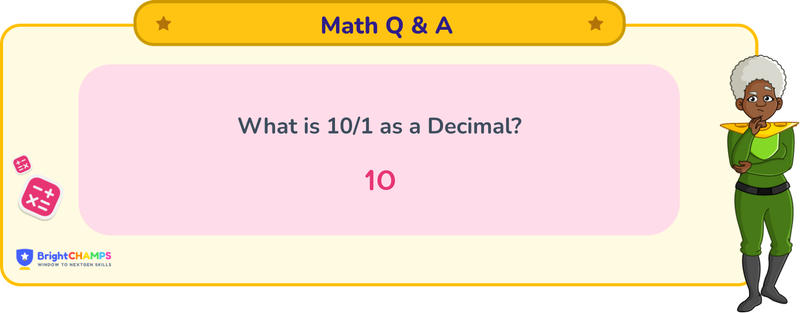
 161 Learners
161 LearnersLast updated on May 26th, 2025

10/1 as a Decimal

It is a simple question on decimal conversion. Firstly, we have to learn fractions and decimals. A fraction represents a part of the whole. It has two parts: the numerator (number on the top) here, 10, represents how many parts out of the whole. The denominator (number below) shows how many parts make the whole; here it is 1. A decimal is a way to represent a number that is not whole, using a (.) or a decimal to separate the whole part from the fraction part. The numbers to the left of the decimal point represent the whole, and that to the right represents the fractional part.
What is 10/1 as a decimal?

Answer
10/1 in decimals can be written as 10.0. It is a terminating decimal, showing that it ends without repeating.
Explanation
To get 10/1 in decimal, we will use the division method. Here, 10 is the numerator, and 1 is the denominator. Let's see the step-by-step breakdown of the process:
Step 1: Identify the numerator and denominator because the numerator (10) will be taken as the dividend and the denominator (1) will be the divisor.
Step 2: Since 10 is larger than 1, we can directly divide 10 by 1.
Step 3: Divide 10 by 1, which equals 10.
Step 4: Since there is no remainder and 1 divides 10 evenly, the decimal representation is 10.0. The process results in a terminating decimal.
The answer for 10/1 as a decimal is 10.0.
Struggling with Math?
Get 1:1 Coaching to Boost Grades Fast !

Important Glossaries for 10/1 as a decimal
- Fraction: A numerical quantity that is not a whole number, representing a part of a whole.
- Decimal: A number that uses the base ten and includes a decimal point to separate the whole part from the fractional part.
- Numerator: The top part of a fraction, indicating how many parts of the whole are being considered.
- Denominator: The bottom part of a fraction, showing how many parts make up a whole.
- Terminating Decimal: A decimal that ends and does not repeat infinitely.




